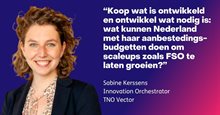There are many questions and uncertainties about the energy transition and the development of our energy infrastructure and energy systems. These include:
- What infrastructure is needed, when and where?
- What are the implications of adaptations for the ‘greening’ of energy producers and consumers?
- Who pays for improvement and who reaps the benefits?
- What is the situation regarding the storage of CO2 and other greenhouse gases?
- Should we invest in energy storage, in the form of gas or electricity?
- Are there sufficient people and materials for new infrastructure?
TNO researcher Harry van der Weijde, a specialist in energy systems and energy infrastructure, explains the study: ‘In questions on renewing the energy infrastructure in the Netherlands, we always study the larger ‘system’ first. Only when we have a clear picture of this does it make sense to zoom in on individual companies or public authorities. After all, we can’t do everything at once.’
Energy infrastructure dependencies
Van der Weijde cites a few examples that highlight how organisations depend on each other and the decisions they make about energy infrastructure.
‘An investment in, say, an energy storage system may not be immediately profitable or beneficial for an individual company. But for an industrial region as a whole, it could work out well.
It’s great if you can work together, but the question is then: how do we shape this into policy? Who makes the investments? And who gets the benefits?’
Van der Weijde adds: ‘Another example is the challenge we face in the housing market. Development of industrial energy infrastructure may mean that a residential area has to wait longer for a connection. And vice versa. How do we make such a decision, and what are the considerations involved?’
Uncertain investments
Energy infrastructure issues are complex and challenging. There are many uncertainties with regard to investment, for example in innovation in electricity transmission, green gases, or raw materials. Innovation in this area often requires a lot of space and is capital-intensive.
Policy decisions on infrastructure are also often far-reaching. There is still a lack of clarity about many technical and other developments, which creates uncertainty and comes at the expense of decisiveness.
This is where TNO Vector can help. By conducting system studies, we draw up a risk profile of an investment or policy decision. Van der Weijde says: ‘Such a risk analysis gives partners and stakeholders guidance when developing policy. This will keep the pace of the energy transition high.’
Toolbox
TNO Vector, together with universities and market players, among others, has developed a comprehensive toolbox to model network systems and markets in detail.
The added value of this toolbox lies mainly in the combination of quantitative and qualitative modelling. It combines practice and theory, bringing together engineering, economics, and process.
The toolbox is available to municipalities and provinces, but it also benefits the national government and regional partnerships, as well as many other parties who ask us for advice. We use the toolbox to develop business cases for energy infrastructure renewal.
The value case method
The ‘value case’ method identifies the financial and societal impact of an investment, for several parties at once, so that they can jointly reach a decision.
For policy decisions, it is important that macroeconomic analysis is also part of the package. What are the implications for employment, for example, or for the earning power of a region or the Netherlands as a whole?
Key role in energy transition
With its knowledge of engineering, economics, and process, TNO Vector plays a key role in the energy transition in the Netherlands. We do so through our vision on energy infrastructure, but also through our knowledge of government policy and the market.
We also share the experience we gain in the energy transition with third parties, in the form of reports, articles, scientific publications, and workshops. And also by exchanging knowledge directly with organisations, companies, politicians, or ministries.
Van der Weijde says: ‘There’s a growing realisation among all stakeholders that the energy transition will only become effective if we seek to collaborate with each other.’
Studies and advisory reports
TNO Vector’s role in the energy transition and renewing energy infrastructure in the Netherlands is reflected by a large array of studies and recommendations. These include the Outlook Energiesysteem 2050 (Energy System Outlook 2050) and reflections on the Cluster Energiestrategieën (Energy Strategies Cluster), together with the Netherlands Environmental Assessment Agency (PBL) and the Netherlands Enterprise Agency (RVO).
When necessary, we also take the lead in bringing parties together to make an innovative move. We call this Innovation Orchestration.



